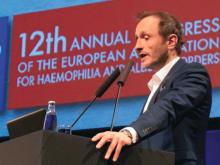PRAGUE – Clinicians should prioritize treatment duration with factors or bypassing agents – not dose level – when managing breakthrough bleeds in patients with hemophilia who are on non–factor replacement therapy, according to a leading expert.
Duration of treatment is more strongly associated with thromboembolism than dose magnitude, said Andreas Tiede, MD, PhD, head of hemostaseology at Hannover (Germany) Medical School in Germany, noting that recommendations vary by non–factor replacement agent.
These remarks were part of a presentation about novel agents for treatment of hemophilia with inhibitors delivered at the annual congress of the European Association for Haemophilia and Allied Disorders.
“Concomitant use of factor products, both factor VIII and IX, and the bypassing agents, have usually preceded thromboembolic events in clinical trials [for non–factor replacement therapies] so this [topic] is crucial,” Dr. Tiede said.
Other experts recommend lower doses and shorter treatment durations. “I think that’s reasonable, but with some question mark behind the low doses,” he said. “I think it depends a little bit on the interaction between the non–factor replacement therapy and the bypassing agent in your patient.”
With a busy pipeline of non–factor replacement agents for hemophilia, such interactions are becoming increasingly relevant for clinicians and their patients.
Emicizumab, for instance, which is now approved for hemophilia with or without inhibitors, has synergistic activity with activated prothrombin complex concentrates (APCC). This was demonstrated by an emicizumab prophylaxis trial in which five out of eight patients with breakthrough bleeding who were treated with APPC at a dose higher than 100 IU/kg per day for more than 24 hours developed thrombotic microangiopathy. (N Engl J Med. 2017;377:809-18).
Other patients who received multiple infusions of APCC developed skin necrosis, cavernous vein thrombosis, and thrombophlebitis. Consequently, it is now recommended that APCC be avoided in patients taking emicizumab, and if unavoidable, given at the lowest dose possible. However, Dr. Tiede advised that this recommendation for APCC should not be extrapolated to encompass all factors and bypassing agents, based on existing data.
“Regarding higher or lower doses for initial treatment, I would be a little bit more careful,” he said. “That obviously depends on [whether] there is a synergistic effect with the non–factor replacement therapy and the bypassing agent. Synergistic effects have clearly been shown for the interaction of emicizumab and APCC, but when it comes to the interaction between emicizumab and VIIa, I’m not so sure. I don’t think that we have enough evidence to recommend lower doses of VIIa.”
Dr. Tiede also suggested that lower doses of factor VIII are probably unnecessary. “At high doses or high concentrations of factor VIII, emicizumab’s low affinity to the targets will not result in any significant action anymore,” he said. “So I think we have to wait for more data from basic research and also more clinical data.”
Regarding concern for duration of therapy, Dr. Tiede explained that, when treating breakthrough bleeding in a patient on non–factor replacement therapy, “the patient’s hemostatic protection level will never fall to zero, as it would have done in a patient treated previously, on demand with bypassing agents only.” Since hemostatic protection levels never return to zero, it is easier to enter the thromboembolic danger zone.
This risk was recently demonstrated by an emerging non-factor replacement therapy. In a phase 3 trial for fitusiran – a small interfering RNA therapy that targets antithrombin – a patient with hemophilia A developed a breakthrough bleed and 31-46 IU/kg of factor VIII was given, resulting in fatal cerebral sinus thrombosis. After a temporary hold, the study restarted with new limits on factor and bypassing agent doses.
Dr. Tiede reported financial relationships with Bayer, Biotest, CSL Behring, Novo Nordisk, Pfizer, and other companies.

